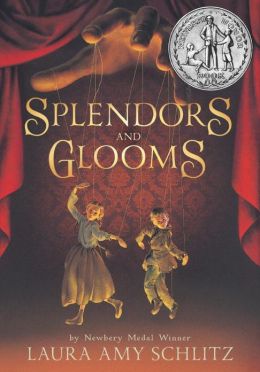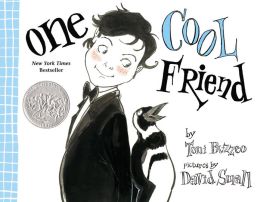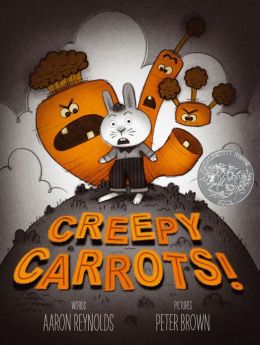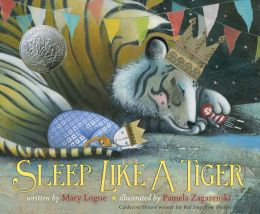One month ago was “Oscar night for Librarians,” when the American Library Association announced their “best of” picks for children’s literature. We’ve given some space to reporting on some of these awards, while waiting for the winners I reserved at my local library to trickle in. The oldest and most coveted award is the Newbery, named for pioneer children’s publisher John Newbery (who also lends his name to Emily’s regular Monday-morning post). We’re so cutting-edge we had already reviewed three of them when the award was announced (The One and Only Ivan, Three times Lucky, and Bomb), but I had to catch up with one more:
Splendors and Glooms, by Laura Amy Schlitz. Candlewick, 2012, 384 pages. Age/interest level: 10-up
London, mid-1800s. Maybe Victoria is the queen; people act and dress as though she were, but we never know because this is magical/alternative London. Clara Wintermute awakens on her twelfth birthday with great anticipation—and it’s high time, after a year spent in the glooms following the death of all four of her siblings in a cholera outbreak. For her party, she has cajoled her grieving parents into engaging “Professor” Grisini and his marionettes—stringed puppets of extraordinary grace. The Professor is assisted by two children, a rude, scruffy little apprentice named Parsefall, and a pretty older girl with a friendly smile: Lizzie Rose. To Clara, who has no real friends, Lizzie Rose is the main attraction, but the puppets have a strong appeal too. Grisini is a genuine artist, but also an evil man—just how evil will soon be apparent when Clara disappears on the night of her birthday, and Lizzie and Parsefall make a shocking discovery a few days later. That discovery leads them to the crumbling country estate called Strachan’s Ghyll and the ancient, bitter Cassandra Sagredo, who holds a grudge against Grisini and may just be a witch.
This actually didn’t sound very appealing to me when I read about it, but there’s more here than meets the blurb. The children are fully developed and believable, and if there’s a little too much spell-casting and mind-reading and enchanted stones for my taste, it’s all building up to something substantial. A clear picture of good and evil emerges, showing how some of us are seduced and some can be saved. (“Witchcraft begins with passion. You’ve a world of strong feeling locked up inside . . . You think it makes you weak, but it doesn’t. It might make you strong, if you knew how to use it.”)
One thing I especially like is that goodness is not to be taken for granted:
From books, [Lizzie] had gathered that if you thought you were good, you probably weren’t, because thinking you were good was conceited. On the other hand, she knew how hard she tried to be good, and she couldn’t help thinking that Madama’s word inconvenient was entirely apropos. It had not escaped her notice that being good was often inconvenient.
Ultimately it’s a story about redemption, with some strikingly Christian overtones. The downside is that “damn” and “damned” are used a lot (often in the literal sense), the many references to God include profanity and there’s one use of the word “bitch” (not in the literal sense). Parents be advised, but I closed the book more pleased than not.
- Worldview/moral value: 4 (out of 5)
- Literary value: 4.5
The Caldecott medal is awarded for outstanding picture books, and this year saw six winners: one medalist and five honors. The gold medal went to This is Not My Hat, with Extra Yarn and Green sporting silver medals. And now for the rest:
 One Cool Friend, by Toni Buzzeo, illustrated by David Small. Dial, 2012, 32 pages. Age/interest level: 4-8.
One Cool Friend, by Toni Buzzeo, illustrated by David Small. Dial, 2012, 32 pages. Age/interest level: 4-8.
“Elliot was a very proper young man,” we’re told, but that information is superfluous: what other kind of third-grader wears a tux on an expedition to the city aquarium? His father is somewhat absent-minded, as we can guess when Elliot, ever polite, asks for a penguin and Dad whips out a $20 bill for the gift shop. But Elliot has something more lively in mind—a live penguin, in fact, which he casually stuffs in his backpack with no one noticing. What kid wouldn’t want to do that? The whimsical narrative builds up to an elaborate punchline, which younger readers won’t get, but they’ll enjoy the cartoony illustrations with dashes of color and collage. They’ll also get a kick out of tracking Dad’s apparent fascination with turtles (there’s no evident mom). The early-sixties feel is reminiscent of Eloise, while the story itself—of course!—brings back fond memories of Mr. Popper’s Penguins.
Creepy Carrots! by Aaron Reynolds, illustrated by Peter Brown. Simon & Shuster, 2012, 32  pages. Age/interest level: 3-6.
pages. Age/interest level: 3-6.
Jasper Rabbit loves carrots—no, he has “a passion for carrots. And the carrots that grew in Crackenhopper Field were the best. Fat. Crisp. And free for the taking.” But then something very creepy happens: it appears the carrots are stalking him. Or are they? Is Jasper really seeing creepy carrots, or is his mind playing tricks on him? Jasper himself isn’t sure, but finally he hits on a solution that will show those carrots who’s in control of the situation. I’ll leave it to readers to find out who has the last laugh, but the pictures are worth some chuckles: noir-ish colors in black frames that look like old horror-movie stills. Even though Creepy Carrots appeared in time for Halloween, I can’t imagine any child being scared by it (though some especially sensitive children may find it a little scary). It might even dispel some of the old monster-under-the-bed fears.
Sleep Like a Tiger, by Mary Logue, illustrated by Pamela Zagarenski. Houghton Mifflin, 2012, 40 pages. Age/interest level: 4-8.
 Many bedtime books (this is one) tackle the problem of the reluctant sleeper: how can we talk him or her into going to bed? And staying there? This busy girl’s parents don’t try: all they ask is that she put on her pajamas. And once in bed, she doesn’t have to go to sleep—not at all. “Does everything in the world go to sleep?” she asks. The parents reply with gentle figures of speech, of snails curling up in their shells “like cinnamon buns,” and bats folding their wings, and even the mighty tiger, who commands sleep like he does everything else. We assume that one reason children fight sleep is not wanting to miss anything, but fear is often part of it: Will Mommy and Daddy still be here when I wake up? Will I have bad dreams again? With tiger protection, all should will be well. The language is soothing and poetic but the real poetry is in the mixed-media illustrations. William Blake’s “Tiger, Tiger, Burning Bright” provided inspiration, and sharp-eyed poetry-lovers can find references to it throughout the book. Why do the family wear crowns? Neither author nor illustrator say, but I like to think those are the proper tokens of human dominion.
Many bedtime books (this is one) tackle the problem of the reluctant sleeper: how can we talk him or her into going to bed? And staying there? This busy girl’s parents don’t try: all they ask is that she put on her pajamas. And once in bed, she doesn’t have to go to sleep—not at all. “Does everything in the world go to sleep?” she asks. The parents reply with gentle figures of speech, of snails curling up in their shells “like cinnamon buns,” and bats folding their wings, and even the mighty tiger, who commands sleep like he does everything else. We assume that one reason children fight sleep is not wanting to miss anything, but fear is often part of it: Will Mommy and Daddy still be here when I wake up? Will I have bad dreams again? With tiger protection, all should will be well. The language is soothing and poetic but the real poetry is in the mixed-media illustrations. William Blake’s “Tiger, Tiger, Burning Bright” provided inspiration, and sharp-eyed poetry-lovers can find references to it throughout the book. Why do the family wear crowns? Neither author nor illustrator say, but I like to think those are the proper tokens of human dominion.
See our 2013 ALA Award post here. And our coverage of this year’s Theodore Seuss Geisel Awards, given for outstanding books for beginning readers.
Support our writers and help keep Redeemed Reader ad-free by joining the Redeemed Reader Fellowship.
Stay Up to Date!
Get the information you need to make wise choices about books for your children and teens.
Our weekly newsletter includes our latest reviews, related links from around the web, a featured book list, book trivia, and more. We never sell your information. You may unsubscribe at any time.
We'd love to hear from you!
Our comments are now limited to our members (both Silver and Golden Key). Members, you just need to log in with your normal log-in credentials!
Not a member yet? You can join the Silver Key ($2.99/month) for a free 2-week trial. Cancel at any time. Find out more about membership here.

